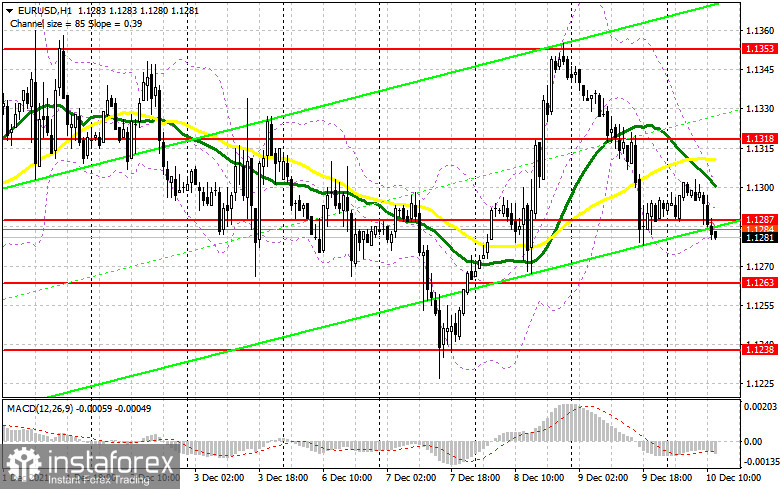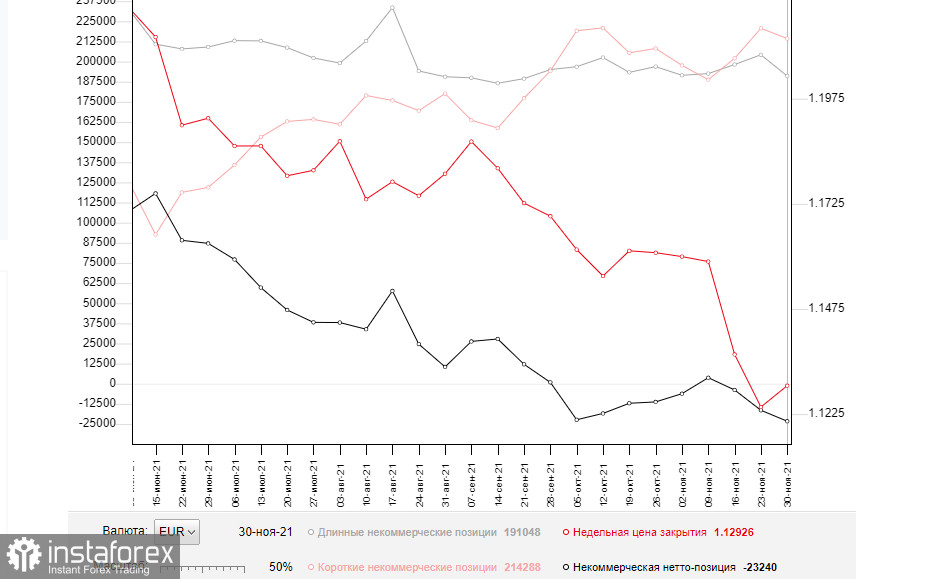For opening long positions on EUR/USD:
In my morning forecast, I paid attention to the level of 1.1287 and recommended entering the market from it. Let's take a look at the 5-minute chart and see what happened. After the release of the inflation data in Germany, which came in line with the forecast, buyers of the European currency made an attempt to protect the support level of 1.1287. The formation of a false breakout generated a good signal to open long positions given that the bear market would end soon. However, this did not result in a strong rise. After a slight upward movement of 12 pips, the euro was back under pressure, and bears managed to break below 1.1287. At the time of writing, the price still hasn't retested this level from bottom to top, so I advise you not to rush into the market.

In the second half of the day, market participants are waiting for important data on inflation in the US which will determine the further direction of the pair. If the report shows a larger increase in the consumer price index for November, the US dollar could significantly strengthen against the euro. As a result, the EUR/USD pair will depreciate. For buyers of the euro, the best scenario for the North American session will be a return to the level of 1.1287. A breakout and consolidation above this range, together with declining US inflation, is likely to restore risk appetite. This will form an excellent entry point for long positions on EUR/USD, considering that the immediate resistance at 1.1318 will be retested. Moving averages are located below this level, which will limit the upward potential of the pair. Only a breakout can seriously affect the EUR/USD downtrend, so be very careful at this level. A breakout and a downside test of 1.1318 would form a larger rally towards the 1.1353 and 1.1381 highs. A further target will be the level of 1.1415 where I recommend taking profit. If the bearish pressure on the euro persists in the afternoon, it is better to postpone purchases until the price hits the support at 1.1263. But most likely, this level will be just an intermediate point. Therefore, you can open long positions at this level only after a false breakout is formed. I advise you to buy EUR/USD immediately on a rebound from the low of 1.1238 or even lower - around 1.1214, considering the possible upward correction of 20-25 pips within the day.
For opening short positions on EUR/USD:
Sellers are gradually returning to the market. After bears have reached the 1.1287 level, there is every indication that they are ready to act if inflation in the US surges again. The best scenario for selling the pair would be after a retest of the level of 1.1287 from bottom to top. This will form an entry point for opening short positions with the prospect of the euro falling to the area of intermediate support at 1.1263. However, the more important target will be the level of 1.1238. Only a breakout and a test from bottom to top of the 1.1263 level will form a sell signal with a further decline in this range. The next target will be the area of 1.1214 where traders will take profit. It is difficult to say, though, how the euro will behave. A breakout of this range will resume the downtrend, and the price may then retest the lows of 1.1188 and 1.1155. If the pair recovers later in the day, I advise you not to rush with opening short positions. The best scenario would be selling the pair when a false breakout is formed in the 1.1318 area. Selling EUR/USD immediately on a rebound is possible from the highs of 1.1353 and 1.1381, considering the possible upward correction of 20-25 pips within the day.

The COT report (Commitment of Traders) for November 30 showed a decline in both short and long positions. However, the rate of reduction in long positions was higher, thus increasing the negative delta. Last week, Fed's Chair Jerome Powell made several statements about the expected tightening of the monetary policy. The reason behind this is the ever rising inflation rate which is no longer considered temporary. This is a matter of concern for the central bank. The second problem was the new Omicron coronavirus strain which will stall the global economy late this year and early next year. It also dampens demand for risk assets. Next week, the Fed is expected to make a decision on the bond purchase program at its regular meeting. So, demand for the US dollar is likely to stay high in the short term. The latest November COT report indicated that the number of long positions of the non-commercial group of traders fell from 204,214 to 191,048, while the short ones declined from 220,666 to 214,288. At the end of the week, the total non-commercial net position increased to -23,240 versus -16,452. The weekly closing price, on the other hand, increased significantly - to 1.1292 versus 1.1241.

Indicator signals
Moving averages
If the pair is trading below the 30- and 50-day moving averages, this indicates that bears are ready to act.
Please note that the author analyzes the time period and prices of moving averages for the H1 chart which differs from the general definition of the classic daily moving averages on the D1 chart.
Bollinger Bands
A breakout of the lower band boundary around 1.1280 will increase the pressure on the pair. In case of growth, the upper boundary of the indicator at 1.1310 will act as resistance.
Description of indicators
• A moving average determines the current trend by smoothing volatility and noise. 50-day period; marked in yellow on the chart;
• A moving average determines the current trend by smoothing volatility and noise. 30-day period; marked in green on the chart;
• Indicator MACD (Moving Average Convergence / Divergence) Fast EMA, 12-day period; Slow EMA, 26-day period. SMA – 9-day period;
• Bollinger Bands: 20-day period;
• Non-commercial traders are speculators such as individual traders, hedge funds, and large institutions who use the futures market for speculative purposes and meet certain requirements;
• Long non-commercial positions represent the total number of long open positions of non-commercial traders;
• Short non-commercial positions represent the total number of short open positions of non-commercial traders;
• The total non-commercial net position is the difference between short and long positions of non-commercial traders.
 English
English 
 Русский
Русский Bahasa Indonesia
Bahasa Indonesia Bahasa Malay
Bahasa Malay ไทย
ไทย Español
Español Deutsch
Deutsch Български
Български Français
Français Tiếng Việt
Tiếng Việt 中文
中文 বাংলা
বাংলা हिन्दी
हिन्दी Čeština
Čeština Українська
Українська Română
Română

